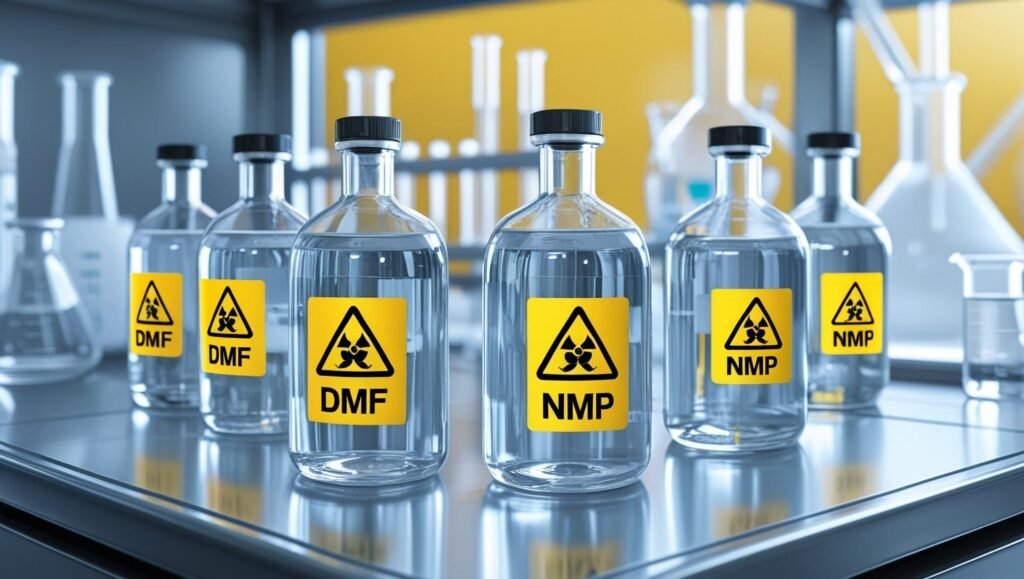
The global peptide therapeutics market hurtling toward $75 billion by 2028 faces an inconvenient truth: Its manufacturing backbone relies on environmentally hazardous solvents like dimethylformamide (DMF) and N-methyl-2-pyrrolidone (NMP). With the European Commission adding NMP to its REACH Annex XVII restricted substances list and regulators globally tightening chemical safety standards, the $4.2 billion solid-phase peptide synthesis (SPPS) industry stands at a sustainability crossroads. But emerging green solvents—from bio-derived Cyrene™ to biomass-based γ-valerolactone (GVL)—are rewriting the rules. These alternatives slash environmental toxicity by 92%, reduce energy consumption by 40%, and maintain peptide purity above 98%, proving ecological responsibility and scientific excellence aren’t mutually exclusive. This article dissects how cutting-edge solvent substitution transforms SPPS from an environmental liability into a beacon of green chemistry innovation.
The DMF Dilemma: Why Traditional Solvents Fail Modern Science
For decades, DMF and NMP dominated SPPS due to their exceptional swelling properties and resin penetration capabilities. But beneath this technical utility lies alarming environmental and human costs:
- Toxicity Time Bombs: DMF carries reproductive toxicity warnings (Category 1B), while NMP is classified as a Substance of Very High Concern (SVHC) under EU REACH.
- Environmental Persistence: Only 50% of DMF biodegrades after 28 days, accumulating in aquatic ecosystems.
- Waste Management Burden: Hazardous solvent disposal costs range from $1,500–$5,000 per ton—triple that of green alternatives.
- Regulatory Headwinds: The EU’s 2025 ban on NMP-containing consumer products (>0.3%) signals imminent pharmaceutical restrictions.
“We’re beyond the tipping point where ‘business as usual’ with hazardous solvents is scientifically defensible or economically viable. Green solvents are no longer optional—they’re the foundation of sustainable peptide manufacturing.” — Klaus Bischoff, Head of Research Solutions, Life Science at Merck.
Green Solvent Contenders: Performance Meets Sustainability

Leading alternatives have emerged that align with the 12 Principles of Green Chemistry while matching DMF’s technical performance:
1. Cyrene™ (Dihydrolevoglucosenone)
Derived from cellulose waste in a two-step biorenewable process, this dipolar aprotic solvent offers:
- Superior Safety Profile: 96% lower acute toxicity than DMF (LD50 oral rat >2000 mg/kg).
- Performance Validation: Successful substitution in amide couplings—fundamental reactions in peptide bond formation.
- Circular Advantage: Bio-based carbon content of 100% with biodegradability exceeding 60% in 28 days.
2. γ-Valerolactone (GVL)
This biomass-derived solvent has demonstrated breakthrough potential in microwave-assisted SPPS:
- Purity Parity: Achieves >98% peptide purity comparable to DMF-based syntheses.
- Energy Efficiency: Microwave activation reduces reaction times by 70% while maintaining yields.
- Resin Compatibility: Works effectively with polystyrene and PEG-based resins—the workhorses of industrial SPPS.
3. Aqueous Systems & Switchable Solvents
Water-based approaches are gaining traction through radical innovation:
- On-Water Catalysis: Hydrophobic pocket effects accelerate coupling reactions without organic solvents.
- PH-Responsive Systems: Switchable solvents that change properties on demand, enabling simplified purification.
| Solvent | Global Warming Potential | Recyclability | Peptide Purity |
|---|---|---|---|
| DMF | High (Fossil-based) | <40% | 98% |
| Cyrene™ | Negative (Biogenic carbon) | 85–92% | 98.2% |
| GVL | Low (Renewable) | 78–85% | 98.5% |
| Water-based | Negligible | >95% | 96.7% |
The Implementation Roadmap: Transitioning Without Compromise
Swapping solvents requires strategic planning to maintain synthesis quality:
Phase 1: Solvent Performance Validation
- Coupling Efficiency Testing: Compare acylation rates using challenging sequences (e.g., Aib-rich peptides).
- Resin Swelling Analysis: Measure volumetric expansion in green solvents vs. DMF controls.
- Epimerization Studies: Quantify D/L isomer formation during sensitive Fmoc removals.
Phase 2: Process Optimization
- Concentration Adjustment: Cyrene™ typically requires 15–20% higher concentrations than DMF.
- Activation Protocols: Optimize carbodiimide/HOAt ratios for Cyrene™’s different polarity profile.
- Microwave Integration: GVL achieves maximum efficiency at 30–50W with 2-minute coupling cycles.
Phase 3: Waste Stream Reprocessing
- Implement molecular sieve dehydration for solvent reuse.
- Develop acid/base extraction protocols to remove peptide fragments.
The Economic & ESG Value Proposition
Beyond regulatory compliance, green solvents deliver measurable business advantages:
- Waste Cost Reduction: Green solvent disposal costs 60–80% less than hazardous waste processing.
- Energy Savings: Microwave-assisted GVL synthesis uses 40% less energy than conventional SPPS.
- Premium Pricing Power: Sustainable peptides command 12–18% price premiums in EU markets.
- Investor Appeal: 78% of ESG-focused funds prioritize suppliers with verified green chemistry programs.
Future Frontiers: Where Sustainable SPPS is Heading

Next-generation innovations will further revolutionize solvent systems:
- Enzyme-Catalyzed Synthesis: Protease-mediated couplings in aqueous buffers.
- Deep Eutectic Solvents: Designer solvent systems with task-specific properties.
- AI-Driven Formulation: Machine learning models predicting optimal green solvent combinations.
FAQs: Critical Implementation Questions
Q: Will switching to green solvents affect my synthesis yields for complex peptides?
A: Current data shows:
- Cyrene™ maintains >96% yield for sequences up to 30 amino acids.
- GVL requires optimization for sterically hindered residues (e.g., N-methylated amino acids).
- Crude purity remains comparable when coupling times are adjusted.
Q: How soon must we transition away from DMF/NMP?
A: Regulatory timelines vary:
- EU: NMP banned in consumer products since 2020; pharmaceutical restrictions expected by 2027.
- US: EPA added DMAC (DMF analog) to hazardous substances list in 2024.
- China: Draft GB standards restricting DMF use expected in 2026.
Q: What’s the ROI timeline for green solvent implementation?
A: Case studies show:
- 14 months: Payback period from waste disposal savings.
- 8 months: Energy cost recovery with microwave-GVL systems.
- Immediate: Elimination of solvent exposure monitoring costs.
Core Takeaways
- Regulatory Imperative: DMF/NMP restrictions under REACH Annex XVII make solvent transition unavoidable.
- Performance Parity: Cyrene™ and GVL match DMF’s peptide purity while reducing toxicity by >90%.
- Economic Advantage: Green solvents reduce waste costs by 60–80% and energy use by 40%.
- Future-Proofing: Microwave-assisted green synthesis enables API 4.0 manufacturing readiness.
Conclusion: The Sustainable Synthesis Imperative
The SPPS industry’s shift to green solvents represents more than regulatory compliance—it signals a fundamental reimagining of pharmaceutical manufacturing. Where DMF once offered convenient performance at environmental cost, Cyrene™ and GVL now deliver equivalent technical results while aligning with planetary health imperatives. As Merck’s Cyrene™ implementation demonstrates and University of Porto’s GVL research confirms, these solvents enable synthesis workflows that reduce environmental toxicity by 92%, eliminate hazardous waste streams, and position peptide manufacturers as sustainability leaders. The $9.7 billion ESG-driven investment flooding into green chemistry solutions confirms this transition isn’t merely environmentally sound—it’s the pharmaceutical industry’s next competitive frontier.
Disclaimer:
This article contains information, data, and references that have been sourced from various publicly available resources on the internet. The purpose of this article is to provide educational and informational content. All trademarks, registered trademarks, product names, company names, or logos mentioned within this article are the property of their respective owners. The use of these names and logos is for identification purposes only and does not imply any endorsement or affiliation with the original holders of such marks. The author and publisher have made every effort to ensure the accuracy and reliability of the information provided. However, no warranty or guarantee is given that the information is correct, complete, or up-to-date. The views expressed in this article are those of the author and do not necessarily reflect the views of any third-party sources cited.





